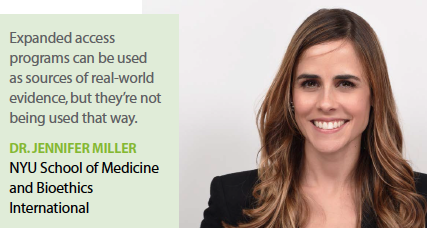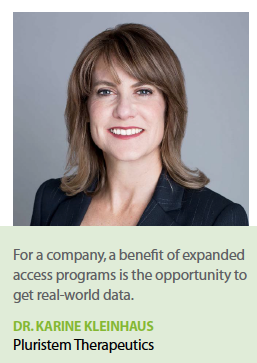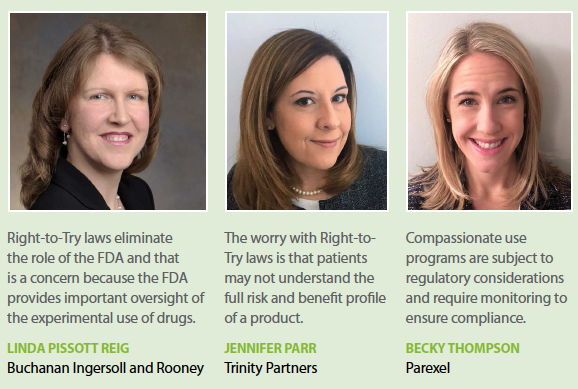Expanded access, or compassionate use as it is sometimes called, is an avenue through which dying patients can access medications that are still being tested in clinical trials by petitioning the company developing the treatment and the FDA for access.
Regulators say for an individual patient to qualify for an Expanded Access program, several criteria must be met, including that the patient must have a serious or life-threatening disease or condition for which there is no comparable or satisfactory alternative therapy. The patient’s physician approaches the pharmaceutical company to ask for its agreement that it will provide the drug being sought.
Bioethics International reviewed therapies that have been offered through expanded access programs that were listed in ClinicalTrials.gov over the database’s entire history: 71% of requests have been for drugs; 11% were for biologics,  and 10% were for medical devices. The review also found that 76% of the drugs that are provided through Expanded Access Programs end up receiving FDA approval.
and 10% were for medical devices. The review also found that 76% of the drugs that are provided through Expanded Access Programs end up receiving FDA approval.
In 2016, the FDA rolled out a simplified form that takes only about 45 minutes to fill out. Previously, the form was the same one used for a full clinical trial and was much more confusing and involved more effort. The new form is accompanied by step-by-step instructions on how to complete it.
Additionally, the agency has released guidance that explains what expanded access is, when and how to submit a request, and what type of information should be included in requests. The FDA also revamped its expanded access website and produced fact sheets for physicians, patients, and industry. Additionally, the agency has introduced a plan to streamline IRB review for expanded access protocols for individual patients.
A provision in the 21st Century Cures Act now requires drug sponsors to make their expanded access policies and contact information publicly available on their websites once a drug candidate is in a Phase II or later trial. A final HHS rule, administered by the National Institutes of Health and the FDA, expands the legal requirements for submission of information to ClinicalTrials.gov about the availability of expanded access for drugs being studied and how to obtain information these programs.
Last year, the regulatory agency collaborated with the Reagan-Udall Foundation, patient advocacy groups, the pharmaceutical industry, and other federal agencies to launch a new online tool called the Expanded Access Navigator. The tool was created to serve as an online resource for information on obtaining investigational therapies to treat patients with serious or life-threatening illnesses who lack therapeutic alternatives. It collects for the first time, in one centralized online location, links to drug manufacturers’ expanded access policies, procedures, and points of contact. The Navigator also includes additional information to help guide patients and physicians through the steps to obtain such treatments.
One company with an expanded access program is Pluristem. In January, the FDA cleared the company’s expanded access program for PLX-PAD cell treatment in patients with critical limb ischemia, which is an advanced stage of peripheral artery disease where fatty deposits block arteries in the legs, leading to pain, non-healing ulcers, and gangrene. Patients with CLI have a high risk of amputation and death, and those patients for which revascularization is unsuitable are left with no adequate treatment options.
As part of the program, Pluristem’s PLX-PAD cell therapy will be made available to a limited number of CLI patients in the United States who cannot take part in the company’s ongoing Phase III clinical study, which is currently enrolling patients in the United States and Europe. Patients who don’t meet the criteria for the Phase III trial of PLX-PAD are eligible for the expanded access program, says Karine Kleinhaus, M.D., divisional VP, North America, Pluristem Therapeutics.
 “One of the exclusions of this trial is uncontrolled diabetes, so these patients wouldn’t be recruited for the study," she says. “We don’t want to siphon people from the trial because the trial is the way to determine if a drug works for the whole population."
“One of the exclusions of this trial is uncontrolled diabetes, so these patients wouldn’t be recruited for the study," she says. “We don’t want to siphon people from the trial because the trial is the way to determine if a drug works for the whole population."
The company’s PLX-PAD in CLI has been selected for accelerated approval pathways in both regions, including the FDA’s Fast Track Designation and the European Medicines Agency’s Adaptive Pathways program.
Right-to-Try Laws
In 2017, the Right-to-Try movement — state laws that provide access to investigational drugs — picked up steam.
Today, 38 states have laws on their books that give patients access to drugs before they are approved by the Food and Drug Administration. The U.S. Senate has approved a Right-to-Try bill, although the effort has stalled in the House.
Designed by the libertarian think-tank the Goldwater Institute, Right-To-Try laws allow terminally ill Americans to try medicines that have completed Phase I of the FDA approval process.
Proponents of Right to Try say FDA red tape and government regulations restrict access to promising new treatments, claiming that it takes doctors 100 hours to complete the application process for FDA approval.
It all sounds good — seriously ill patients with no other options may want the opportunity to try something that isn’t yet proven — but some experts we spoke with express concern about these laws. The concern is that Right-to-Try laws take regulatory oversight out of the equation, allowing patients to appeal directly to the drug manufacturer.
Our experts worry about safety and lack of oversight without the controls of the FDA. Even some patient organizations — such as the National Organization for Rare Disorders and the Association of Clinical Research Organizations — oppose the laws, primarily because of a concern for safety.
“The Right-to-Try laws eliminate the role of the FDA and that is a concern because the FDA provides important oversight of experimental use of drugs," says Linda Pissott Reig, co-chair of the bio-section of the law firm Buchanan Ingersoll and Rooney.
Jennifer Parr, engagement manager at Trinity Partners, says through the FDA’s expanded access program, an institutional review board looks at the application and considers the patient and the product and the benefit and risks to the patient.
“The risk review piece is missing in the Right-to-Try laws," she says. “The worry is that there could be patients who may not understand the full risk and benefit profile of a product."
 Ms. Parr also points out products eligible under the Right-to-Try laws only have to have cleared Phase I, so no efficacy data have been established.
Ms. Parr also points out products eligible under the Right-to-Try laws only have to have cleared Phase I, so no efficacy data have been established.
“There is an argument to be made that the patient can’t make an informed decision around the risks and the benefits because these drugs are being used so early," she says. “There are a lot of arguments about whether Right-to-Try is giving false hopes or are setting patients up to have negative consequences that they’re not even aware of."
Jennifer Miller, Ph.D., assistant professor of NYU and founder of Bioethics International, says Right-to-Try laws alone don’t improve the ability of patients to access investigational drugs; these laws likely increase risks without benefits.
“Why would we want to bypass the FDA, when it efficiently approves 99% of expanded access requests?" she asks.
The FDA understands there are patients who are fighting serious or life-threatening diseases who want the flexibility to try new therapeutic approaches, including access to investigational medical products, says Sandy Walsh, who is with the office of media affairs at the FDA. “For more than 20 years, the FDA has been committed to ensuring that the Expanded Access program works well for patients, and we have recently made significant improvements to its functioning and efficiency by streamlining the process for requesting Expanded Access, introducing a shorter form for physicians to fill out and providing updated, helpful resources to patients and physicians," she says.
The FDA receives more than 1,000 applications annually for expanded access to treat patients with investigational drugs and biologics. The FDA authorizes 99% of these requests. Emergency requests for individual patients are usually granted immediately over the phone and non-emergency requests are generally processed within a few days.
In 2017, FDA Commissioner Scott Gottlieb, M.D., testified that the FDA makes meaningful changes in about 10% of applications for expanded use to enhance patient safety. For example, modifications may be made to adjust dosing amounts, increase safety monitoring, and bolster informed consent.
Ms. Reig points out that without the federal government acting, state Right-to-Try laws remain somewhat ineffective in achieving the purpose that they are seeking to achieve, which is to make it easier for patients to access these medications.
“The Senate’s proposal is an effort to remove the FDA from the process and permit patients, doctors, and drug companies to determine on their own whether an experimental treatment can be used in a particular patient," she says. “But FDA-mandated patient safeguards are important. If we move too aggressively, the line between approved drugs and investigational treatments will blur. Patient safety, plus the promise of new medicines built upon well-controlled clinical trials, may be put in jeopardy."
Opportunities and Challenges
Industry leaders say compassionate use programs offer an opportunity for companies to collect real-world evidence ahead of market access, provide a way to build relationships with treating physicians and patients, supplement the existing risk-benefit profile of a product, and allow payers an opportunity to evaluate real-world benefits.
“More data are always valuable for a company that’s preparing a product for approval," Dr. Kleinhaus says. “Real-world data provides a lot of valuable information, not just on whether the product is safe, but insights on how the product is being used and how the doctor is administering the product in a real scenario rather than in a controlled trial scenario. There’s a lot of value to these data alongside the data of a controlled Phase III trial."
Dr. Miller says while expanded access programs can be used as sources of real-world evidence, they’re not being used that way.
“We need to understand how drugs work for the general patient," she says. “Since we test drugs on highly specialized populations in clinical trials, expanded access programs may be a helpful solution. However, we will need to create the infrastructure for standardizing data collection and analysis."
On the flip side, compassionate use programs are subject to unique regulatory considerations, says Becky Thompson, associate director, real world evidence solutions at Parexel.
“For starters, regulatory requirements and guidance are fragmented across different countries and regions and there is no standardization in the processes or requirements for running these programs," she says. “Moreover, in countries with regulations related to compassionate use, there may be multiple types of programs allowed depending on the circumstances. An added regulatory issue is that as the investigational product progresses through market authorization and commercialization, the regulatory requirements to run a compassionate use program may change in some countries. This dynamic environment requires constant monitoring of the regulatory landscape to ensure compliance."
Ms. Thompson says providing early access to investigational products can be both time-consuming and expensive for a pharmaceutical or biotech company.
“Requests for access often peak before the product is on the market, and this is a time when a company may be stretched for resources, including financial, staffing, product supply, etc.," she says.
FDA officials point out that companies can deny requests for access for a variety of reasons. They may have produced only a limited quantity of the product as companies ramp up manufacturing after marketing approval, have minimal resources to administer expanded access requests, or have concerns that granting requests for expanded access may exacerbate the challenge of recruiting clinical trial participants — and delay product development.
Additionally, expanded access programs require that any data collected be submitted to the agency. This means that adverse events would have to be included in the profile of the drug.
“In effect, an expanded access program could put a clinical trial program in jeopardy," Ms. Parr says. “It looks like the Right-to-Try laws take that component away, so in a sense the pharmaceutical company is not liable for any negative consequences that might happen to the patient."
Ms. Walsh from the FDA says the agency has seen some reluctance among companies to provide investigational drugs for expanded access. This may have been due, in part, to uncertainty about how data for adverse events that occur during treatment under expanded access are viewed by the FDA. Companies have voiced concerns that any apparent negative effects might jeopardize the product’s development.
To clarify how adverse event data in these circumstances are viewed, the FDA recently updated the guidance for the industry entitled, Expanded Access to Investigational Drugs for Treatment Use: Questions and Answers. The guidance clarifies that suspected adverse reactions must be reported “only if there is evidence to suggest a causal relationship between the drug and the adverse event."(PV)
~~~~~~~~~~~~~~~~~~~~~~~~~
A Review of Expanded Access
Jennifer Miller, assistant professor at NYU School of Medicine, and founder of Bioethics International, a nonprofit organization focused on the ethics, patient-centricity, and governance of how medicines are researched, developed, marketed, and made accessible to patients, studied the FDA’s approval rate of experimental drugs provided through expanded access programs.
The study, coauthored by Ken Moch, Joseph Ross, and Arthur Caplan, found most drugs (76%) provided through registered expanded access and compassionate use programs eventually receive FDA marketing approval. The study also found drug safety or efficacy data from expanded access programs are generally not made public. In fact, only 2% of expanded access programs data are publicly reported on ClinicalTrials.gov.
The pharma industry was the largest sponsor of expanded access programs.
















